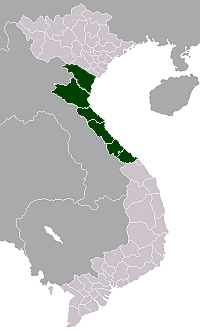Vũ Quang
| Vu Quang National Park Vườn quốc gia Vũ Quang | |
|---|---|
| District | |
| Country |
|
| Region | North Central Coast |
| Province | Hà Tĩnh |
| Capital | Vũ Quang |
| Area | |
| • Total | 249 sq mi (646 km2) |
| Population (2003) | |
| • Total | 32,242 |
| Time zone | UTC + 7 (UTC+7) |
Vũ Quang is a remote forested region of Vietnam, in which several new species of deer and antelope have been discovered since the 1990s. Some are so new that scientific description is still pending, although most have local names.
Vu Quang, in the Hà Tĩnh Province of Vietnam's North Central Coast, is an area of steep mountains and dense rainforest. It is a very wet, hot area, whose mountains trap moisture coming in from the South China Sea. This creates a very stable, but inhospitable climate. It rains continually in the rainy season, and in the dry season there is much fog; consequently most surfaces are algae-coated and slippery. The local hunters prefer to stay out of the forest, setting snares and using dogs to chase animals into more accessible areas.
As of 2003 the district had a population of 32,242.[1] The district covers an area of 646 km². The district capital lies at Vu Quang.[1]
History
Vũ Quang was used as a base by Phan Đình Phùng, the anti-colonial revolutionary, from 1885-96.
The area was declared a forest reserve in 1986 and a National Park in 2002. The National Park has an area of 212 square miles (550 Square kilometers).
List of new animals
New animals from Vũ Quang and surrounding areas:
- Saola or Vu Quang ox (Pseudoryx nghetinhensis)
- Quang khem ("slow deer")
- Giant muntjac (Megamuntiacus vuquangensis) - the world's largest muntjac.
- Mangden ("black deer")
- Linh dương ("holy goat") (Pseudonovibos spiralis) - this or a similar species has been seen in Cambodia, where its name is kting voar
In addition, Vũ Quang is home to five new species of fish:
- Parazacco vuquangensis
- Crosscheilus vuha
- Pararhoedus philanthropus
- Pararhoedus equalitus
- Oreoglanis libertus
In addition to these animals, there are some tantalising glimpses of more:
- a large, cream-coloured slow loris seen in Hanoi Zoo by Doug Richardson, assistant curator of mammals at London Zoo in 1994;
- a black muntjac seen in Laos by Dr George Schaller of New York's wildlife Conservation society in 1994;
- the skull and some meat from the Vietnamese warty pig Sus bucculensis was given to Dr Schaller on the same visit. The species was first described in 1892 but no physical evidence for it was ever secured.
References
- 1 2 "Districts of Vietnam". Statoids. Retrieved March 20, 2009.
Further reading
- Karl Shuker (2002). The New Zoo: New and Rediscovered Animals of the Twentieth Century. House of Stratus, Thirsk. ISBN 1-84232-561-2
External links
- http://www.time.com/time/magazine/printout/0,8816,980918,00.html
- http://www.birdlifeindochina.org/source_book/pdf/4%20North%20central%20Coast/Vu%20Quang.pdf
| ||||||||||||||||||||||||||||
Coordinates: 18°17′30″N 105°24′30″E / 18.29167°N 105.40833°E
